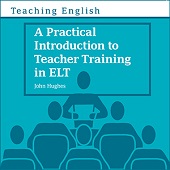10 techniques for teacher training sessions
John Hughes is an ELT author of course books and teacher resources including ETpedia. He’s also a teacher trainer and writes a blog called www.elteachertrainer.com. His new book ‘A Practical Introduction to Teacher Training in ELT’ is packed with practical advice, training tips and workshop ideas for anyone involved in teacher training. In this blog post, he suggests 10 different techniques for any trainer who is looking for different ways to run an input session, either face-to-face or online.
Whether you’re running a workshop for your fellow teachers at your school or you’re leading a formal input session on a course like the CELTA, there are a range of techniques you can use in your sessions. Here are ten of them.
1. A talk or lecture

 Because ELT teacher trainers come from language teaching backgrounds, we tend to regard the idea of giving a talk or lecture as ‘bad’ in some way; it leads to too much teacher talking time. However, in training sessions, a lecture with only you speaking is often well-received. Participants will be more than happy to benefit from your experience or knowledge on an area of ELT and take notes. With online courses, you could deliver the talk live using a tool such as Skype or you could video record your lecture so participants can watch it to suit their own schedule.
Because ELT teacher trainers come from language teaching backgrounds, we tend to regard the idea of giving a talk or lecture as ‘bad’ in some way; it leads to too much teacher talking time. However, in training sessions, a lecture with only you speaking is often well-received. Participants will be more than happy to benefit from your experience or knowledge on an area of ELT and take notes. With online courses, you could deliver the talk live using a tool such as Skype or you could video record your lecture so participants can watch it to suit their own schedule.
2. A ‘How to’ demonstration
Especially on training courses for new teachers, you will want to demonstrate how to do something; for example, ‘how to drill students’ or ‘how to present vocabulary’. Participants will need to pretend they are students and you teach them as if they are students. Afterwards, leave time for questions and discussion about what happened and why.
3. A poor ‘How to’ demonstration
As an alternative to the idea above, you could also present a teaching technique badly and then afterwards ask the participants what they think you did wrong. For example, this works well with giving classroom instructions badly.
4. Peer teaching
When you have presented an idea for teaching, put the participants into pairs. So if you have been looking at how to present a grammar item, give each person a new grammar item, ask them to prepare a presentation, and then they peer teach it to their partner.
5. Read an article
One way to change the dynamic of teacher training session is to hand out a relevant article and ask participants to read it for five and ten minutes. Afterwards, discuss the main points of what the author has said and how it might relate to everyone’s teaching. This kind of task also works well with online training courses. You’ll find lots of good articles to use in your training sessions in the journals English Teaching Professional and Modern English Teacher (both published by Pavilion Publishing and Media).
6. Show a video
You Tube now has a number of extracts from real classrooms with teachers working in different contexts. It can be really helpful to support a training session by showing part of a lesson. It could be to show how something is done or for a task such as observing the types of errors students make and ways in which a teacher might handle them. You could also video parts of your own lessons and share it with participants.
7. Discussion
Teacher training sessions usually include time for discussion either in pairs, groups or as a group. As we know from teaching language with our students, discussions generally work best after you have provided some input (such as a reading or video) which will provoke different viewpoints. With online courses, you can set up a forum which allows the discussion to be extended over a longer period of time with trainees working asynchronously.
8. Loop input
I first learned about ‘Loop Input’ from Tessa Woodward who also edits the journal The Teacher Trainer. The basic idea behind Loop Input is that trainees learn about a teaching technique and experience the process at the same time. For example, if you are looking at ways to use dictation, you read out a text about dictation and ask participants to write it down word for word; so they are learning about dictations as well as doing a dictation. Another way loop input would work is to give trainees a reading on ‘How to teach reading’ and set them questions and exercises that you would typically do with a reading text in a course book.
9. Poster presentations
Ask participants in a training session to work in groups and create a poster which displays their ideas on a topic. For example, if you were running a workshop on ways to get students speaking, different groups could create a set of ideas which they present visually. Towards the end of the session, everyone stands up and walks around the room looking at each other’s posters. As an online variation, set up a course blog or Facebook group so that participants can share their ideas online.
10. Quizzes
As with language learning, it’s always important to build in moments to review and revise ideas. This is particularly true for extended courses such as a course leading to a TKT or Diploma qualification. A quiz or element of competition is a fast ways to energise participants on a training course and a helpful revision tool. So if your course includes lots of linguistic terminology or names of methodologies and approach, then you could start a session with a quiz where you read out a term and different team members have to define it in order to win a point. 
For more ideas on ways of running teacher training sessions, take a look at John’s book ‘A Practical Introduction to Teacher Training in ELT’.
Comments
Write a Comment
Comment Submitted